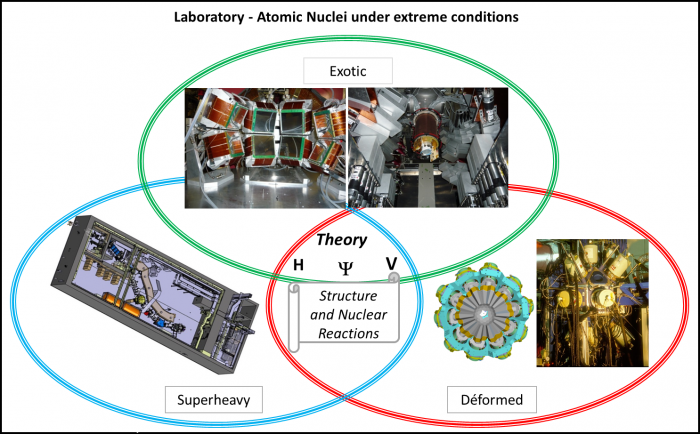The LENA group laboratory conducts experimental programs on the structure and spectroscopy of the nucleus in extreme states, following three research axes:
• the structure of exotic nuclei with neutron halos or skins, low energy resonances, modifications of the standard shell structure,
• shapes and deformations of nuclei, which may have very different shapes in the vicinity of their ground state,
• and the spectroscopy of very heavy nuclei (region of transfermium nuclei and beyond).
The LENA Nuclear Structure Theory Group develops models that aim to extend our understanding of the emergence of nuclear phenomena based on theories of low-energy nuclear interactions. In particular, the scope is to develop a complete interpretation of the experimental results on the nuclear chart by carrying out ab initio calculations.
Exotic nuclei are studied by nuclear reactions induced with stable (GANIL, Jyväskylä) or radioactive beams (SPIRAL at GANIL, RIBF at the Nishina Center of RIKEN in Japan).
Given the characteristics of the radioactive beams in terms of intensity and energy, appropriate, precise and efficient tools are needed to carry out these studies:
- at GANIL we use the VAMOS magnetic spectrometer, the EXOGAM detector for gamma spectrometry, or the MUST2 telescope array for the detection of light recoil particles, projects for which IRFU contributed strongly in the 2000s -2010.
- at RIKEN we use the MINOS detector, developed by IRFU, in coincidence with the gamma spectrometer DALI2, to study the spectroscopy of the very rare exotic nuclei produced by the RIBF facility.
The LENA projects are in line with the prospects offered by future machines, which will extend the range of radioactive beams in Europe:
- SPIRAL2 at GANIL
- FAIR (Facility for Antiproton and Ion Research) at GSI, and the R3B project,
- EURISOL, European machine for the second generation of radioactive beams.
The experiments envisaged with the stable and radioactive ion beams produced by the new generation machines require the design and realization of detection instruments with increased performances. Programs have been developed in recent years to build detectors that will replace current spectrometers and telescopes.
The IRFU is a key player in the construction of the SPIRAL2 machine and in the development of instrumentation projects associated with the group's programs:
- the AGATA (Advanced GAmma Tracking Array) gamma spectrometer,
- the S3 spectrometer (Super Separator Spectrometer),
- the cryogenic H2 reaction target CHyMENE (A Thin HYdrogen Cryogenic target for the study of Exotic Nucleus).
More information on our programs, detection devices, experiments, theoretical and experimental projects on the various pages of the LENA laboratory:
- Shapes of nuclei,
- Exotic nuclei, neutron-deficient or neutron-rich, towards the drip lines,
- Superheavy nuclei
- Nuclear Structure Theory.


